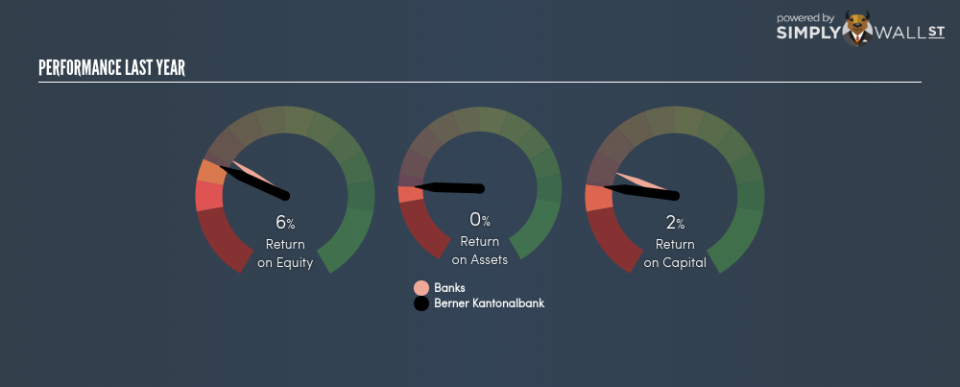Did Berner Kantonalbank AG (VTX:BEKN) Create Value For Investors Over The Past Year?

I am writing today to help inform people who are new to the stock market and want a simplistic look at the return on Berner Kantonalbank AG (VTX:BEKN) stock.
Berner Kantonalbank AG’s (VTX:BEKN) most recent return on equity was a substandard 5.51% relative to its industry performance of 6.98% over the past year. An investor may attribute an inferior ROE to a relatively inefficient performance, and whilst this can often be the case, knowing the nuts and bolts of the ROE calculation may change that perspective and give you a deeper insight into BEKN’s past performance. Metrics such as financial leverage can impact the level of ROE which in turn can affect the sustainability of BEKN’s returns. Let me show you what I mean by this. Check out our latest analysis for Berner Kantonalbank
Breaking down ROE — the mother of all ratios
Return on Equity (ROE) is a measure of Berner Kantonalbank’s profit relative to its shareholders’ equity. It essentially shows how much the company can generate in earnings given the amount of equity it has raised. In most cases, a higher ROE is preferred; however, there are many other factors we must consider prior to making any investment decisions.
Return on Equity = Net Profit ÷ Shareholders Equity
Returns are usually compared to costs to measure the efficiency of capital. Berner Kantonalbank’s cost of equity is 10.80%. This means Berner Kantonalbank’s returns actually do not cover its own cost of equity, with a discrepancy of -5.29%. This isn’t sustainable as it implies, very simply, that the company pays more for its capital than what it generates in return. ROE can be broken down into three different ratios: net profit margin, asset turnover, and financial leverage. This is called the Dupont Formula:
Dupont Formula
ROE = profit margin × asset turnover × financial leverage
ROE = (annual net profit ÷ sales) × (sales ÷ assets) × (assets ÷ shareholders’ equity)
ROE = annual net profit ÷ shareholders’ equity
The first component is profit margin, which measures how much of sales is retained after the company pays for all its expenses. The other component, asset turnover, illustrates how much revenue Berner Kantonalbank can make from its asset base. The most interesting ratio, and reflective of sustainability of its ROE, is financial leverage. Since financial leverage can artificially inflate ROE, we need to look at how much debt Berner Kantonalbank currently has. At 173.74%, Berner Kantonalbank’s debt-to-equity ratio appears relatively high and indicates the below-average ROE is already being generated by significant leverage levels.
Next Steps:
While ROE is a relatively simple calculation, it can be broken down into different ratios, each telling a different story about the strengths and weaknesses of a company. Berner Kantonalbank exhibits a weak ROE against its peers, as well as insufficient levels to cover its own cost of equity this year. Also, with debt capital in excess of equity, ROE may already be inflated by the use of debt funding, raising questions over the possibility of further decline in the company’s returns. Although ROE can be a useful metric, it is only a small part of diligent research.
For Berner Kantonalbank, there are three pertinent aspects you should further research:
Financial Health: Does it have a healthy balance sheet? Take a look at our free balance sheet analysis with six simple checks on key factors like leverage and risk.
Future Earnings: How does Berner Kantonalbank’s growth rate compare to its peers and the wider market? Dig deeper into the analyst consensus number for the upcoming years by interacting with our free analyst growth expectation chart.
Other High-Growth Alternatives : Are there other high-growth stocks you could be holding instead of Berner Kantonalbank? Explore our interactive list of stocks with large growth potential to get an idea of what else is out there you may be missing!
To help readers see pass the short term volatility of the financial market, we aim to bring you a long-term focused research analysis purely driven by fundamental data. Note that our analysis does not factor in the latest price sensitive company announcements.
The author is an independent contributor and at the time of publication had no position in the stocks mentioned.

 Yahoo Finance
Yahoo Finance 

